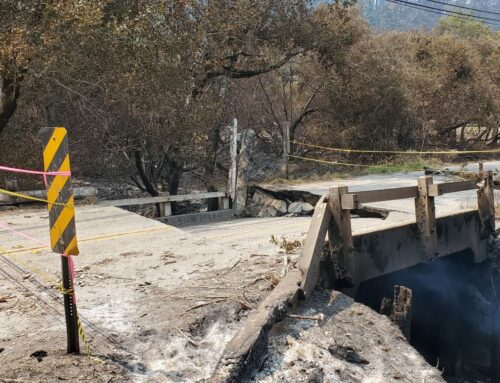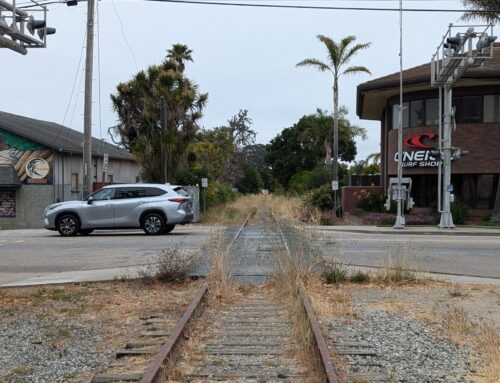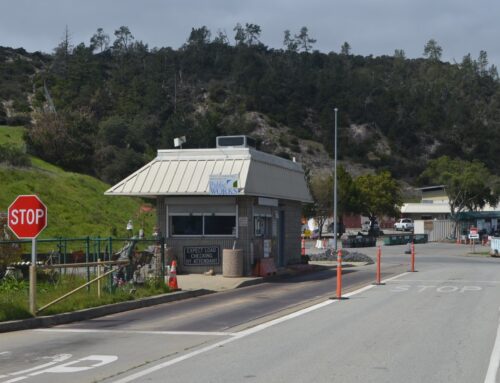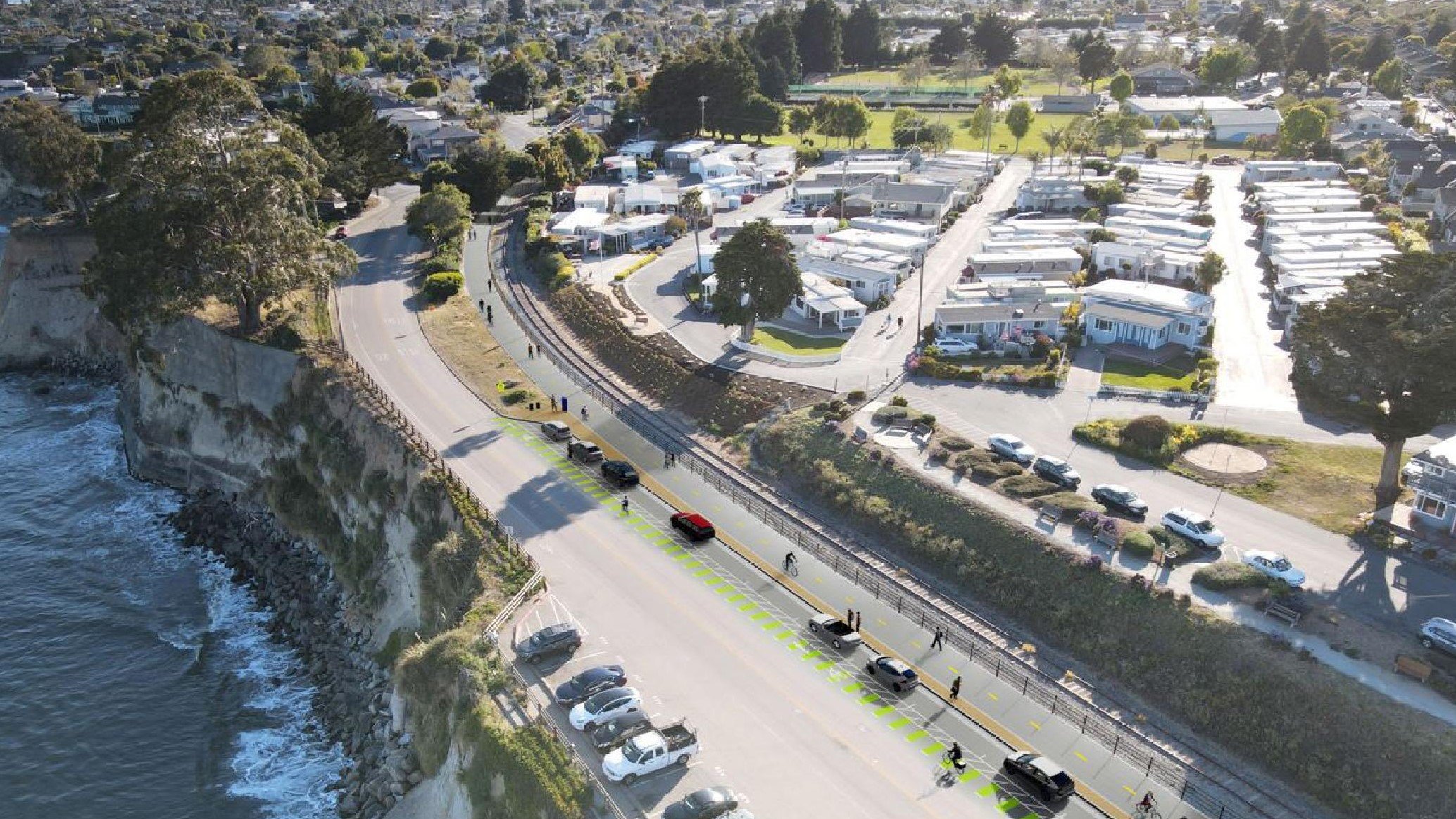
A rendering shows a version of Segment 11 of the rail trail on Cliff Drive in Capitola. (Santa Cruz County Regional Transportation Commission)
SANTA CRUZ >> A Santa Cruz County supervisors vote on Tuesday shocked county staff and left an uncertain future for the rail-trail project through Live Oak, Capitola and Seacliff.
- The board accepted environmental review for a portion of the rail trail, but it did not approve any of three options for the trail design.
- The lack of approval could risk a $68 million state grant for the rail trail, county staff said.
“The whole idea of whether we have a recreational trail across Santa Cruz County is currently on life support,” said County of Santa Cruz spokesperson Jason Hoppin. “I don’t know what happened on Tuesday.”
Koenig, in an interview, said he was not concerned about losing grant funding. “I think those concerns are wildly overblown at this point,” he said. “If I believed that we were putting those funds seriously at risk, I wouldn’t have voted the way I did. I believe that we’re still on pretty solid ground here.”
Supervisors vote
At Tuesday’s meeting, county staff presented the final environmental review for Segments 10 and 11 of the rail trail. The segments stretch from 17th Avenue in Live Oak through Capitola to State Park Drive in Seacliff.
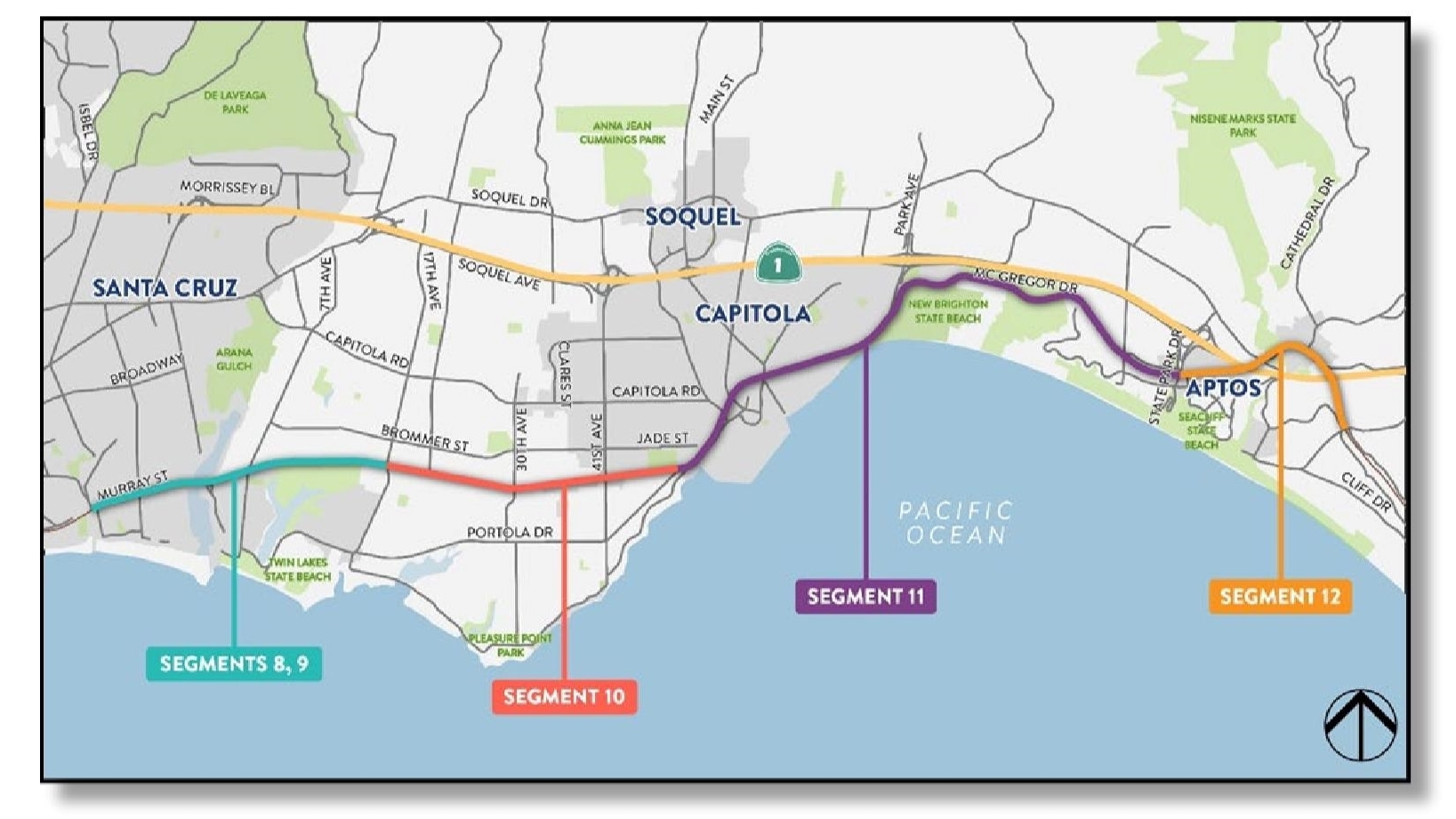
A Santa Cruz County supervisors vote on March 26 stalled plans for Segments 10 and 11 of the Coastal Rail Trail. (Santa Cruz County Regional Transportation Commission)
The report included three options:
- An “ultimate” walking and biking trail parallel to the railroad tracks. County staff recommended that supervisors approve this option. Several other segments of the rail trail have been or are being built in this way.
- An “interim” paved path where the railroad tracks now stand. It would be replaced by a permanent path parallel to the tracks.
- A paved path without plans for passenger rail service. The report was commissioned before the failure of Measure D in 2022. In that election, more than 73% of voters signaled a preference for passenger rail service next to a paved trail, voting that the county’s General Plan should not be changed to favor a paved trail only.
Tuesday, county supervisors voted 3-1 to accept the environmental documents. They did not approve the ultimate or the interim trails, nor allow county staff to enter an agreement with the California Department of Transportation needed to receive a $68 million grant awarded in 2022.
The board instead directed county staff to:
- Consider reducing trail size at Escalona Gulch to preserve trees.
- Reach an agreement with Roaring Camp Railroads to move the rails.
- Direct the Santa Cruz County Regional Transportation Commission staff to identify potential cost-cutting measures for the project.
- Request a regional transportation commission report about how city and county requests for more money for rail-trail funding would impact 2017 Measure D funds. Measure D in 2017 was a half-cent sales tax approved by voters that helps pay for transportation projects across the county.
Supervisors Manu Koenig, Bruce McPherson and Felipe Hernandez voted yes to accept the environmental documents and direct county staff. Supervisor Justin Cummings voted no. Supervisor Zach Friend recused himself because he owns property next to the rail trail.
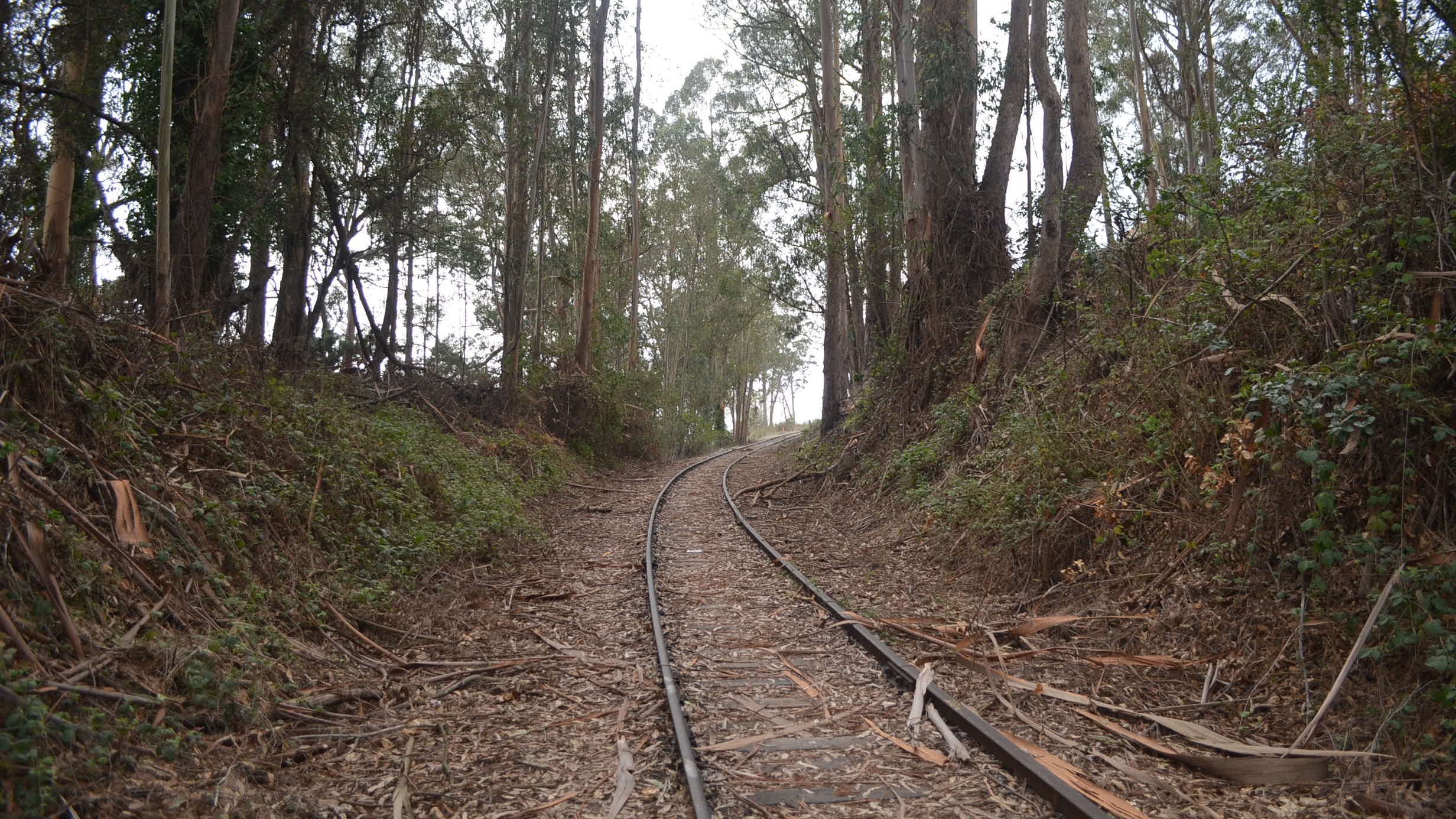
Segment 11 of the Coastal Rail Trail runs near New Brighton State Beach in 2021. (Stephen Baxter — Santa Cruz Local file)
Money sources juggled
Although most of the trail for Segments 10 and 11 would be paid for with a $68 million state grant, the project has a $28 million funding gap. County planner Rob Tidmore suggested the regional transportation commission’s 2017 Measure D sales tax revenue fill the gap. Koenig said using that would take money away from trail construction in South County.
In an interview, Cummings said that putting a mid-county trail in jeopardy because of concerns for a South County trail “doesn’t make sense.” He added, “The longer we delay, the longer the cost of materials goes up, cost of labor goes up, cost of everything goes up while we’re just sitting here.”
Hernandez initially voted with Cummings to move forward with the “ultimate” trail, but later changed his vote to break a potential 2-2 stalemate. Hernandez represents District 5, which includes much of South County.
“I want to see the projects in South County happen, but I’m also concerned about [receiving grant funding for] future projects,” he said during Tuesday’s meeting. “I’d like to see us move forward and you know, not delay the process.” Hernandez, in an interview, said his change of vote was “trying to salvage something, so we can continue the process.”
Even if Segments 10 and 11 did use Measure D funds, the regional transportation commission could vote to re-allocate money budgeted for other priorities to avoid depleting funds for the South County trail, said commission spokesperson Shannon Munz. Some Measure D money is budgeted for highways, public transit, and contributions to cities and the county for local projects.
But commission staff would rather plug the funding gap with more state and federal grants, said Munz. The regional transportation commission has applied for a federal grant that would include $8.4 million for Segments 10 and 11, and is requesting congressional earmarks, she said.
Large public projects like the rail trail often begin construction before they have secured all necessary grant money, said Munz and Hoppin.
“There’s a saying in the business that no project is ever fully funded until it’s built. And that’s an acknowledgment that these kinds of things are not unusual whatsoever,” Hoppin said. “We’re confident that we can identify the funding necessary or find reductions and still have a viable project.”
Koenig said he’s not confident that the county or regional transportation commission can win more grants to close the budget gap for Segments 10 or 11. Although the county has won large grants in the past, “those days are gone, at least for the immediate future,” Koenig said. “It’s a very different budget environment in the state capitol.”
During the supervisors meeting Tuesday, McPherson said the supervisors should wait to approve construction on Segments 10 and 11 until the regional transportation commission publishes a planned passenger rail concept study. The study is expected in early 2025.
McPherson said he expects that report may find that building passenger rail is financially infeasible. “The decision we make today must be informed by the facts, and not the wishful thinking that many of us we’ve been hearing over the years,” he said.
Grant money in jeopardy
The supervisors’ vote endangers a $68 million state grant awarded in 2022, county staff said. Staff had planned to submit an agreement with the California Department of Transportation at the June meeting of the California Transportation Commission. The agreement would include a preliminary schedule and spending plan. County staff now plan to request an extension to submit the agreement.
If the state commission doesn’t “give us an extension on that agreement, then that money goes away,” Hoppin said. The request for an extension could make the California Transportation Commission less confident in Santa Cruz County leaders’ ability to carry out large projects, he said. “I would worry about future funding not only for [the rail trail], but future funding for other projects,” he said.
It’s not clear when county and regional transportation commission staff would be able to fulfill the requests from supervisors, said Tidmore, the county planner, during the Tuesday meeting. County and commission staff expected to hammer out an agreement with Roaring Camp, identify more grant funding and find ways to cut construction costs in the two years before construction is expected to start, he said.
“There’s just a lot up in the air right now and a lot of unknown,” said Munz, the transportation commission spokesperson. “We do have concern about the grant funding.”
“Between now and when we’re breaking ground there is likely going to be plenty of time for us to continue to explore funding opportunities,” said Cummings. “To stop right now, because we don’t have everything in place, I think will be a waste of one of the largest grants the states have allocated for this kind of project,” he said.
Cummings said he hopes his fellow supervisors and county staff can reach an agreement to receive the grant funding. “I think that, based on what the voters expressed with Measure D [in 2022], moving forward with the rail and trail is what the community wants, and so I think we need to honor that,” he said. The county could be vulnerable to a lawsuit from voters if supervisors don’t move forward with the rail trail, he said.
Rail supporters and opponents
After McPherson voted with Koenig, Friends of the Rail and Trail pointed out that voters in McPherson’s district overwhelmingly supported passenger rail and trail by voting against Measure D in 2022.
“The people of Santa Cruz County should be deeply concerned about the lack of leadership shown by Supervisors McPherson and Koenig,” wrote Friends of the Rail and Trail Board Chair Matt Farrell, in a statement. “We remain bullish on the rail trail project and will not be deterred by this week’s vote.”
Some rail skeptics see the supervisors’ vote Tuesday as fiscally responsible.
Nadene Thorne, a 2022 Measure D supporter and a longtime supporter of a trail only, echoed Koenig’s concerns about funding.
Thorne said she believes the 2022 Measure D vote does not compel county leaders to pursue a train. County supervisors “are going to have to be the grownups and say, ‘Well, you might want this but is it really going to work? And can we really afford it?’”
Questions or comments? Email [email protected]. Santa Cruz Local is supported by members, major donors, sponsors and grants for the general support of our newsroom. Our news judgments are made independently and not on the basis of donor support. Learn more about Santa Cruz Local and how we are funded.
Jesse Kathan is a staff reporter for Santa Cruz Local through the California Local News Fellowship. They hold a master's degree in science communications from UC Santa Cruz.



